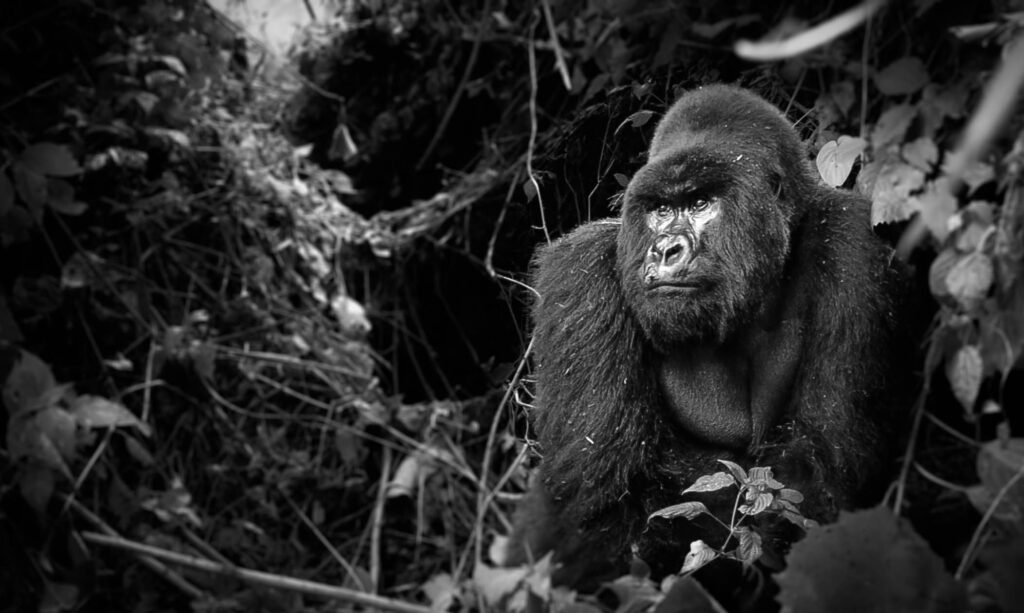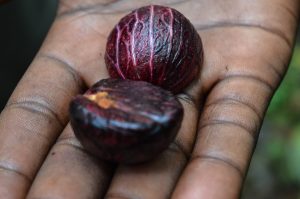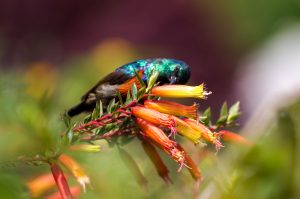Student researchers come face to face with wildlife in the Rwandan mountains.

As we approach a forested gulley about three hours in, François raises his arm suddenly. We stop dead in our tracks and suck in our breaths, peering over each other’s shoulders. And then we see her— eyeing us deliberately, but unconcerned, her infant cradled in her arms: the first of the mountain gorillas we had hiked so long to see.
Amy Vedder, who has worked with these gorillas for over 30 years, has a slight grin starting on her face, like she is beginning to recognize an old friend. She shares her experiences as a professor and leader of the field course that has brought our small group of students, all studying various aspects of conservation, to Rwanda. We are able to visit Volcanoes National Park as tourists— and more specifically, able to view the mountain gorillas— largely because of the work of Amy and her husband, Bill Weber.
***

Amy and Bill were quite young when they began their work, entering the landscape at a time when many leading conservation organizations had dismissed mountain gorillas as beyond saving. They recognized that with conservation success, the heaviest of any subsequent burdens— from restrictions on forest use, to wildlife damage to crops adjoining park borders— would be shouldered not by NGOs, the government, or the international community, but by local people. Any ethical conservation strategy would need to include the people it impacted most. With this in mind, they conceived of a conservation model based around tourist visitation of groups of gorillas that had been carefully habituated to human presence, hoping that a tourism enterprise could generate enough revenue to economically justify the preservation of the forest— and therefore, the gorillas themselves.

What began as a bold and perhaps outlandish proposal is now a trilateral agreement between the Democratic Republic of Congo, Uganda, and Rwanda, and the largest source of foreign revenue in Rwanda. In the intervening years, despite the unthinkable challenge of rebuilding after the atrocities of the 1994 genocide and subsequent unrest, the Rwandan government has made prolific gains in conservation and economic development. This is largely due to the presence of a strong, top-down government able to propose and implement projects with rigid efficiency. Nevertheless, tourism in Rwanda’s national parks fund the preservation of the parks and their biodiversity, generate national wealth, and support local communities through profit-sharing plans, microloans, cooperatives, and compensations.
***
I’m drawn from my reverie as François gestures for us to step back. We are a little too close to the animals— visitors must stay at least seven meters away, a rule proposed for the safety of both gorilla and human parties, particularly to avoid human viruses being passed to gorillas.
To give the mother and child ample space, we attempt to pass through a hollow tree to observe from the other side of the gulley. I trail behind my peers only to see them turn quickly back, gesturing urgently for me to turn as well: they had entered the hollow tree only to find the space occupied by a pair of amorous gorillas, who cried out at the boorish intrusion. We retreat, but find the path we came from occupied by an agitated juvenile male pacing back and forth, back and forth. I’m surprised at the silence of his step, and how quickly he appeared. He must have been close to us. To avoid him, we climb over a fallen tree and walk down the gully to watch the gorillas upslope at a proper distance. By now two females have emerged and are feeding on the bark of the dead tree we just climbed over. A baby plays a game of climb up the log and fall back off it, climb up the log and fall back off it, on to mom, over and over again. We are still slightly closer than ideal, but our guide indicates for us to stop. There is no route for us to leave the gulley that isn’t currently blocked by a gorilla, so we will stay still until they choose to move on. We are confined by the brush behind us. We press into it, and watch the scene ahead.

Suddenly, the vines to my left shake again, and just as it occurs to me to be concerned, a huge silverback rushes to the scene with surprising speed. He runs up and smacks the fallen tree with a crack that echoes through the gulley. The female agitators flee, while the others, like their human spectators, freeze. The silverback has his back to us and is far too close. At the same time, we humans realize that we are spread in a line downslope, blocking his only exit from the clearing. I look behind me at my usually exuberant classmate Ana—her face is ghost white. I look ahead and see the ever-thoughtful Martin, who seems truly enraptured. Finally, I turn to Amy, and she is smiling. For a brief moment, I’m convinced that we are going to be charged by a 350-pound silverback gorilla, and that Amy is smiling to keep us calm.
But instead, for a very long while, nothing happens. My group stands, waiting. The silverback doesn’t seem to take note of us at all. He keeps his back to us, without even a glance in our direction. This habituated group is just that— habituated. To the silverback, tasked with the protection of his group, we smell unremarkable. Unthreatening. Familiar. I’m struck by the fact that despite having flown 7,000 miles and hiking for hours to be here, my presence is an unexceptional part of his normal routine. Far from the otherworldly “wild” I had imagined, this landscape was a complex tapestry of natural systems and layers of human intention, value, and need, intimately intertwined. In fact, had we chosen, we could have visited a group ten minutes from the parking lot— while still other, unhabituated groups live deep in the forest, far from tourist eyes.

Eventually, the other gorillas move on as well. They go back into their hollow tree; they melt into the leaves, back under the logs, and into the vines again. And it’s just us now, a group of humans, mouths agape and eyes still frozen wide, looking at each other.